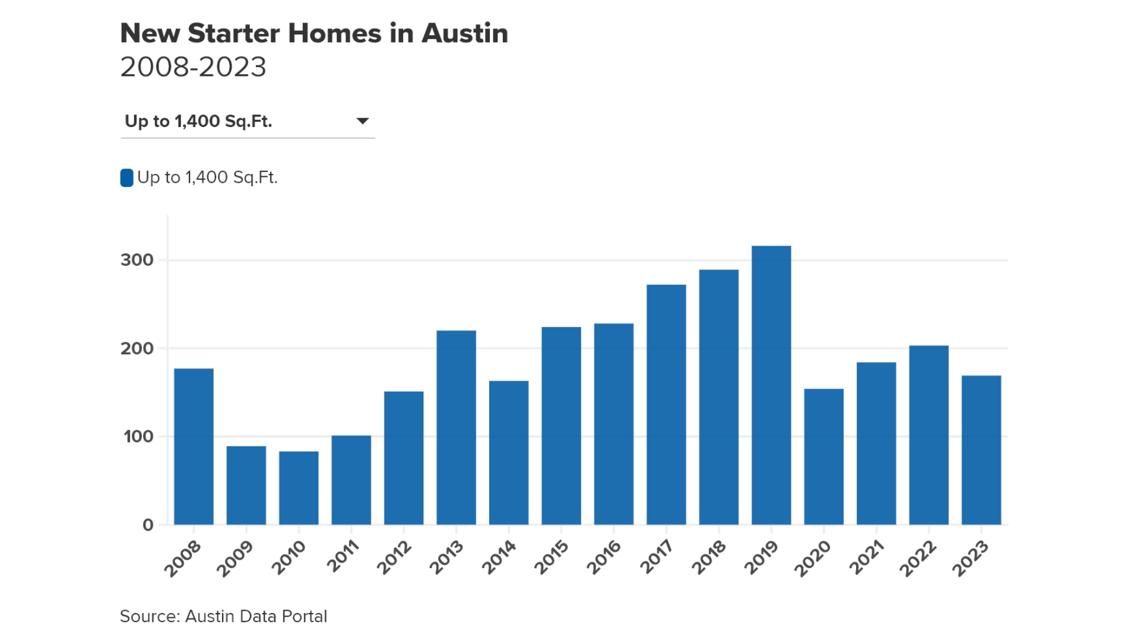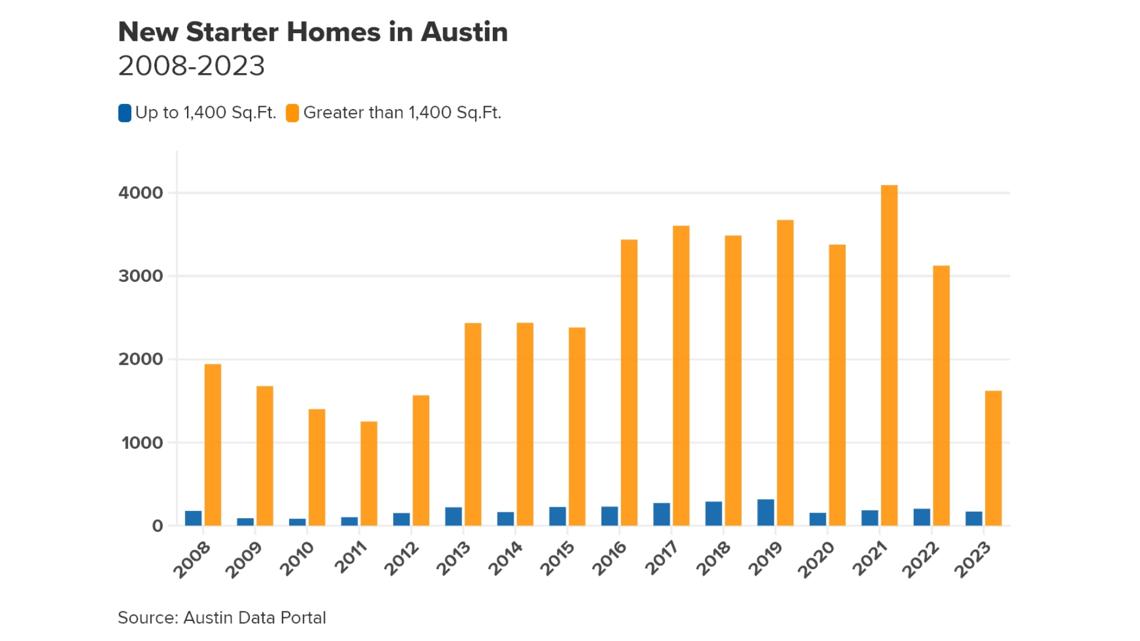AUSTIN, Texas — Building a home in Austin can sometimes be like piecing a puzzle together for builders like Scott Turner, the owner of Riverside Homes, LLC.
Turner builds new homes inside Austin’s established neighborhoods.
In 2019, Turner bought a corner lot off Jester Drive, near St. David’s South Austin Medical Center. He demolished the existing home, divided the land and built two homes on each lot.
What was one house there is now four, adding three more homes to the city’s housing supply.
“They are very much just like all the other houses around here in terms of their function. They're freestanding. They have separate yards. They have driveways and garages and so on,” Turner said.
But it wasn’t easy. Turner said the project took four years, three-quarters of it in the subdividing process. After the space was divided into two single-family lots, Turner said it took about a year to get through the City of Austin’s permitting process and build the homes.
Turner had to work around some of the established trees, forbidden by Austin’s land code to remove. He had to create enough parking for everyone and keep enough space between the homes to meet land and fire codes.
The homes are not cheap. While the final home sales price in Texas is private, Turner said he listed the two larger homes of nearly 2,000 square feet each at $900,000. He said he listed the smaller, 930-square-feet homes at $600,000.
The median home price at the time was $550,000. As of Nov. 17, that price dropped to $540,000.
Next door, a different builder was constructing a new home on a similar sized lot. Turner said that his neighbor’s home will sell for more than $2 million, proof to Turner that density housing would lower the price point for a home in Austin.
“It'd be great if I could get three tiny homes on one of these lots so they are closer to the median home price,” Turner said.
It would be illegal for Turner to build those three homes on one single-family lot. In Austin, a lot zoned for a single family must be at least 5,750 square feet. In certain areas close to jobs, schools and city transit, extra restrictions meant to limit large homes also limit duplexes and townhomes.


In those areas, Austin’s development standards place an imaginary tent over anything built here.
The height for a new home or duplex is capped between 32 and 35 feet depending on the flood plain. Plus, developers must make room for front, side and backyard setbacks.
“At its core, that's exclusionary,” Turner said.
Exclusionary zoning laws place restrictions on what type of homes can be built in a neighborhood.
Turner knows Austin needs more affordable housing and said Austin’s land development code deters dense developments and makes it difficult to build starter-sized homes with a starter-sized price tag.
“I don't think anyone would say that Austin's median home price right now is affordable, certainly not to the average Austin. But nonetheless, those three smaller homes are going to sell for less than that one big single family home with one family living in it,” Turner said.
While there is no standard size for a starter home, a 2021 analysis by the government-backed lender Freddie Mac defined a starter home as one with 1,400 square feet.
The Austin Data Portal shows the amount of homes no larger than 1,400 square feet built in Austin in the last 15 years. The data shows less than 300 homes were built a year and mostly along the west side of town.


Compare those numbers to the thousands of larger single-family homes of greater than 1,400 square feet that have been built in the past 15 years.


Turner said this disparity is one reason for Austin’s continuing affordability crisis.
“The simplest and easiest thing for me to build is a big, single-family home on a big, single-family lot. The code incentivizes me as a home builder to do that,” he said.
But that may soon change.
Members of the Austin City Council will soon vote on changing some development codes, including how many homes are allowed on a single-family lot and could raise it from two to three. The City may also reduce the lot square footage requirement for a single family from 5,750 square feet to 2,500 square feet.
City records show that 297 people voiced their opinion during the Joint City Council and Planning Commission Meeting on Oct. 26. Dozens of others gave new comments during the Planning Commission meeting on Nov. 14. In total, most folks said they wanted smaller lots, smaller homes, and denser neighborhoods.
Monica Bhatia, a grad student at The University of Texas at Austin, told council members and city planning commissioners that she wants restrictions loosened around who can live in a home.
Bhatia lives in cooperative housing, where residents own shares of equity in the home.
“The code as it stands now has really been a big barrier,” she told the KVUE Defenders.
Bhatia also told city council members that zoning rules around who can live in a home limit housing opportunities.
“Housing cooperatives are some of the most affordable housing options available in Austin,” Bhatia said in the Oct. 24 meeting.
In Austin, no more than four unrelated people can live in a single-family or duplex home unless it meets certain exceptions under § 25-2-511 - DWELLING UNIT OCCUPANCY LIMIT.
“We're a lot of people who are choosing to share our lives together and get the benefits of having community, having people to come home to and ask you about your day or you're having a crisis, someone to support you. But it just looks a little different than the mainstream,” she said.
Not everyone is on board. During the Oct. 26 meeting, more than 100 people spoke in opposition to the proposed changes.
“I know we need affordable housing. I am not against it. I'm just not for this plan,” Anne Budroni said in the meeting.
“This is an investor land grab,” Arlington Helbing said.
“Density does not equal affordability,” Sean McCarthy said.
Even if the City does decide to change how many homes can be on a lot, reduce the lot size requirement and change how many unrelated people can live on one piece of land, not every neighborhood will be impacted.
Homeowner associations and deed restrictions may carry private agreements that are more powerful than a City zoning ordinance. So those areas won’t change without a legal fight.
In 2012, a report by the Institute for Urban Policy Research and Analysis at The University of Texas at Austin showed dozens of properties across the city with land use restrictive covenants. While some of them have been challenged and removed by court order, Turner said it is the responsibility of a builder to research each property before buying.
“Without this kind of change, without offering more types of housing options like this, then homeowners really are going to have to drive further and further out of the city to find a place to live. And we see that happening today,” Turner said.
He said he will continue to build denser housing, work each land puzzle and hope the laws change soon.
The city council will hear more public testimony on Dec. 7. Members of the public are encouraged to leave feedback online at speakupaustin.org.
Boomtown is KVUE's series covering the explosive growth in Central Texas. For more Boomtown stories, head to KVUE.com/Boomtown.

